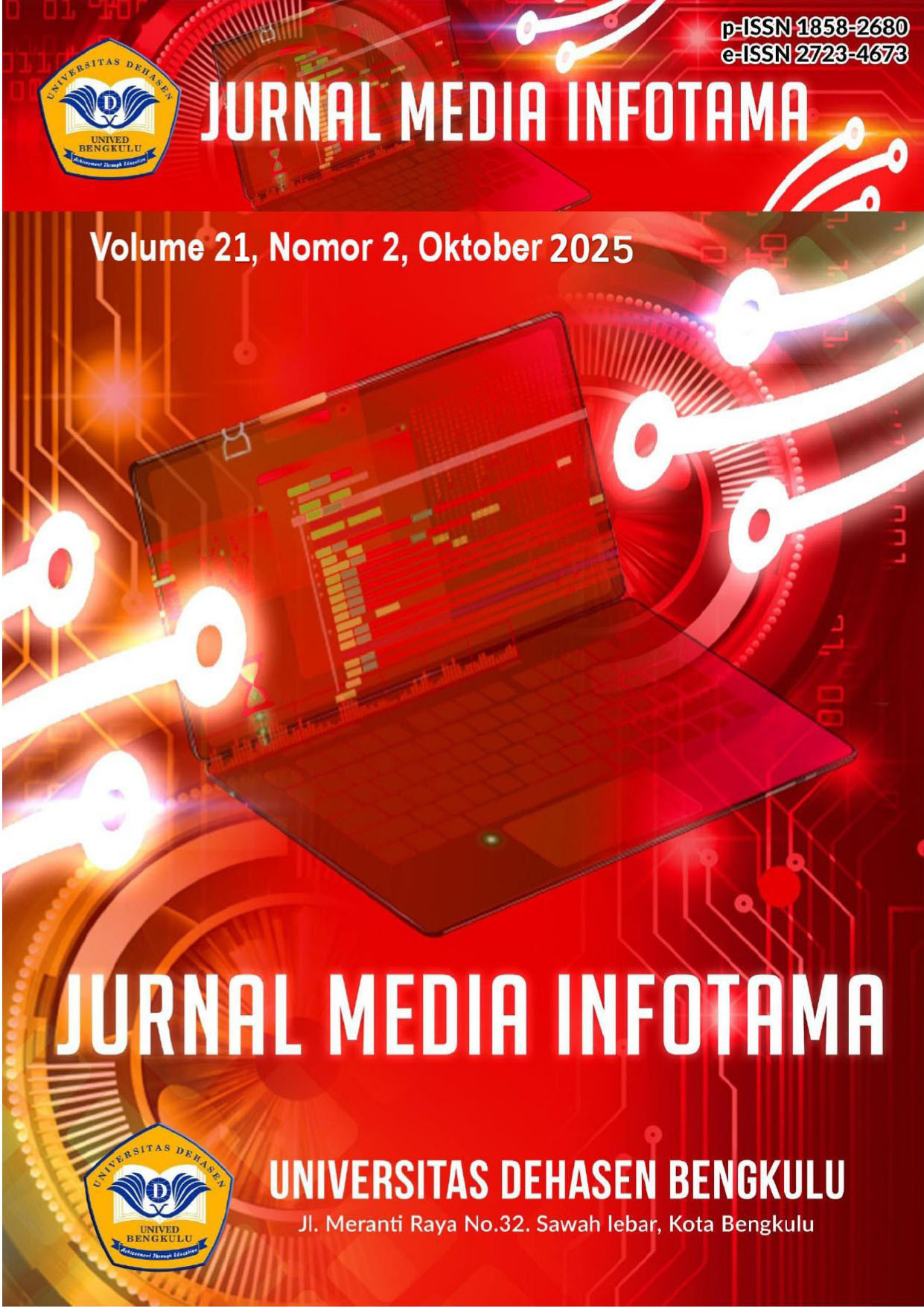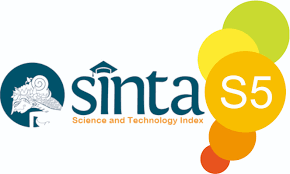3D Model Bahan Ajar Pengenalan Hewan Berbasis Augmented Reality
Abstract
his study aims to develop an interactive learning media based on Augmented Reality (AR) technology to support the introduction of animals to elementary school students. The learning media is designed in the form of 3D animal models that visually represent the name, habitat, and characteristics of each animal. The 3D models were developed using Blender software and implemented into the AR Web Studio platform, allowing users to scan markers using a mobile device camera and display animal objects in real-time. The research method used is Research and Development (R&D), consisting of several stages: problem formulation, data collection, media development, implementation, and system evaluation. Testing was conducted using two approaches: technical testing with the black-box method and user testing through questionnaires distributed to several elementary school teachers. The technical testing results showed that all system features, such as marker detection, 3D model display, and user interaction, functioned properly. Meanwhile, user testing revealed an average satisfaction score of 76.9%, which falls into the “Good” category. Based on these results, it can be concluded that the AR-based animal learning media is feasible to use and provides a positive contribution to increasing students’ interest and understanding of the learning material in an interactive manner.
Downloads
References
[2] Apen Sitinjak, B., Dita Mahatmanti, A., Natalia, D., Putri, A., Zahra Majidiah, K., Teknik Informatika, J., Palangka Raya Jl Yos Sudarso, U. & Raya, P., 2023, Implementasi Augmented Reality Pada Pengenalan Hewan Menggunakan Univity dan Vuforia.
[3] Arifin, A., & Rachmadyanti, P. (2022). Penerapan Blender sebagai alat bantu pembelajaran 3D interaktif. *Jurnal Teknologi dan Pendidikan*, 6(1), 22–30.
[4] Asniati, H., Hamsinar & Dodiman, D., 2024, ‘Pengembangan Aplikasi Anatomi Hewan Menggunakan Augmented Reality Berbasis Android’, Jurnal Ilmu Pendidikan Interaktif, 9(2), 55–63.
[5] Darmawan, A.T.P., 2024, LAPORAN TUGAS AKHIR PERANCANGAN APLIKASI AUGMENTED REALITY.
[6] Fathoni, K., Setiowati, Y. & Muhammad, R., 2020, ‘Rancang Bangun Aplikasi Modul Pembelajaran Satwa Untuk Anak Berbasis Mobile Augmented Reality’, JURNAL MEDIA INFORMATIKA BUDIDARMA, 4(1), 32.
[7] Fauzi, M.I., 2024, LAPORAN TUGAS AKHIR PERANCANGAN MEDIA PERMAINAN EDUKATIF.
[8] Firmansyahputra, B. & Cherid, A., 2020, ‘Aplikasi Multimedia Pengenalan Huruf Alfabet, Buah dan Hewan Menggunakan Teknologi Augmented Reality’, Jurnal Telekomunikasi dan Komputer, 9(3), 173.
[9] Hakim, L., 2023, PENGEMBANGAN MEDIA PEMBELAJARAN PAI BERBASIS AUGMENTED REALITY.
[10] Huerta, O., Kus, A., Unver, E., Arslan, R., Dawood, M., Kofoğlu, M. & Ivanov, V., 2021, A Design-Based Approach to Enhancing Technical Drawing Skills in Design & Engineering Education Using VR and AR Tools.
[11] Humaira, N., Rahayu Teknik Komputer, S., Sukabumi Jl Babakan Sirna No, P., Warudoyong, K., Sukabumi, K. & Barat, J., 2020, Prosiding SEMNASTERA (Seminar Nasional Teknologi dan Riset Terapan).
[12] Karni, A., Astarini, D. & Sa’adah, D.Z., 2024, ‘A Booklet based on Islamic Parenting to Prevent Sexual Violence for Children and The Implications on Counseling’, KONSELOR, 12(4), 259–272.
[13] L.Maknun, 2024, PENGEMBANGAN MEDIA PEMBELAJARAN ETNOMATEMATIKA BERBANTUAN AUGMENTED REALITY TERHADAP KEMAMPUAN BERPIKIR KREATIF SISWA KELAS VIII B MTs NEGERI 1 GROBOGAN.
[14] Mazroui, K. Al & Alzyoudi, M., 2024, ‘The role of ChatGPT in mitigating loneliness among older adults: An exploratory study’, Online Journal of Communication and Media Technologies, 14(4).
[15] Mirza, T., Dutta, R., Tuli, N. & Mantri, A., 2025, Leveraging augmented reality in education involving new pedagogies with emerging societal relevance, Discover Sustainability, 6(1).
[16] Muhaimin, A. & Syaihul Huda, W., 2024, PERANCANGAN DAN IMPLEMENTASI MEDIA PENGENALAN NAMA HEWAN MENGGUNAKAN BAHASA INGGRIS UNTUK ANAK TK, vol. 8.
[17] Pramudita, 2024, REVISI PROPOSAL: JUDUL PENELITIAN PENGEMBANGAN PROTOTIPE SEPEDA MOTOR HIBRID MELALUI PEMBELAJARAN BERBASIS PROYEK.
[18] Putra, G., Prihatin, W.T., Semarang, U.N. & Prastyo, A.K., 2023, ‘ENHANCING EARLY CHILDHOOD LEARNING EXPERIENCE WITH AUGMENTED REALITY MODELING OF ANIMALS AND DEEP LEARNING Seftia Kusumawardani’.
[19] Ritonga, I., Suryani, I. & Tambunan, E.P.S., 2023, ‘Pengembangan Media Pembelajaran Interaktif Berbasis Android Materi Keanekaragaman Hayati Untuk Siswa SMA’, Jurnal Jeumpa, 10(2), 184–194.
[20] Riduwan., 2012, Dasar-dasar Statistika, Bandung: Alfabeta.
[21] Rossa, A., 2024, LAPORAN TUGAS AKHIR PERANCANGAN APLIKASI AUGMENTED REALITY.
[22] Saputra, R. & Suryanto, H., 2021, ‘Pengembangan Model 3D Menggunakan Blender untuk Pembelajaran IPA’, Jurnal Teknologi Pembelajaran, 10(2), 98–105.
[23] Sugiyono., 2019, Metode Penelitian Kuantitatif, Kualitatif, dan R&D, Bandung: Alfabeta.
[24] Sukmawati, F., Santosa, E.B. & Rejekiningsih, T., 2023, ‘Virtual Reality-Based Learning about “Animals Recognition” and Its Influence on Students’ Understanding’, 25(2), 269–284.
[25] Suryani, I.D., 2023, PROSIDING SEMINAR NASIONAL JURUSAN MATEMATIKA 2023.
[26] Tan, Y., Xu, W., Li, S. & Chen, K., 2022, Augmented and Virtual Reality (AR/VR) for Education and Training in the AEC Industry: A Systematic Review of Research and Applications, Buildings, 12(10).
[27] Wibowo, V.R., Eka Putri, K. & Amirul Mukmin, B., 2022, ‘Pengembangan Media Pembelajaran Berbasis Augmented Reality pada Materi Penggolongan Hewan Kelas V Sekolah Dasar’, PTK: Jurnal Tindakan Kelas, 3(1), 58–69.
[28] Yılmaz, Z.A. & Gözüm, A.İ.C., 2023, ‘Augmented reality app in pre-school education: Children’s knowledge about animals’, Southeast Asia Early Childhood Journal, 12(2), 130–151.
[29] Z.Abidin, 2024, ‘Pendidikan Guru Sekolah Dasar (PGSD)_34302000090_fullpdf’.
Copyright (c) 2025 Yovi Apridiansyah; Sastya Hendri Wibowo, Muntahanah Muntahanah; Nugraha Apriansyah

This work is licensed under a Creative Commons Attribution-ShareAlike 4.0 International License.
An author who publishes in Jurnal Media Infotama agrees to the following terms:The author holds the copyright and grants the journal the right of first publication of the work simultaneously licensed under the Creative Commons Attribution-Share Alike 4.0 License which allows others to share the work with acknowledgment of the work's authorship and initial publication in this journal.Submission of a manuscript implies that the submitted work has not been previously published (except as part of a thesis or report, or abstract); that it is not being considered for publication elsewhere; that its publication has been approved by all co-authors. If and when a manuscript is accepted for publication, the author retains the copyright and retains the publishing rights without limitation.
For new inventions, authors are advised to administer the patent before publication. The license type is CC-BY-SA 4.0.
MEDIA INFORMATION REVIEW: Journal of the Faculty of Computer Science is licensed under a Creative Commons Attribution-ShareAlike 4.0 International License.You are free to:Share
— copy and redistribute material in any medium or formatAdapt
— remix, modify and develop materialfor any purpose, even commercial.
The licensor cannot revoke this freedom as long as you follow the license terms












.png)


